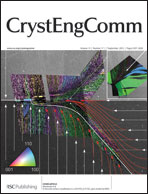A series of group 12 metal complexes, [ZnCl2L2]·H2O (1), [ZnBr2L2]·0.75EtOH (2a), [ZnBr2L2]·0.8H2O (2b), [ZnI2L2] (3), [HgCl2L2] (4), [HgBr2L2] (5), and [HgI2L] (6), have been synthesized from a naphthyl-substituted pyridylurea ligand N-(1-naphthyl)-N′-(3-pyridyl)urea (L) and zinc(II) or mercury(II) halides. In the zinc(II) dichloro complex, 1, the chloride ions participate not only in metal coordination but also in N–H⋯Cl hydrogen bonding with the urea NH groups, giving an overall layered structure. In contrast, the coordinated bromide and iodide anions in 2 and 3 are not involved in hydrogen bonding; instead, the urea groups undergo self-association to form nano-tubular structures with various pore sizes stacked by the semi-macrocyclic [ZnX2L2] synthons. Most interestingly, although different solvent molecules [EtOH (2a) and H2O (2b)] can be encapsulated in the nano-tubular zinc dibromo complexes, a competitive experiment conducted in the EtOH/H2O mixed solvents showed that the nanotube can selectively capture the EtOH molecule, as confirmed by X-ray single-crystal diffraction and solid-state fluorescence studies. With the tetrahedral mercury(II) ion, complexes 4 and 5 are isomorphous 2D sheet structures held by N–H⋯O hydrogen bonds and π–π stacking interactions. The 2D sheets are further linked by C–H⋯Cl/Br weak interactions into a hydrogen-bonded 3D framework. Notably, compound 6 contains an uncommon trigonal-planar HgII center and forms a 1D chain structure via the typical urea⋯urea hydrogen bonding and π–π stacking interactions of L, which further aggregates to a 2D parallelogram grid framework through C–H⋯I weak interactions. The solid-state fluorescent properties of L and the complexes 1–6 have also been investigated at room temperature.


 Please wait while we load your content...
Please wait while we load your content...